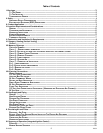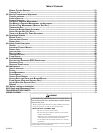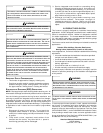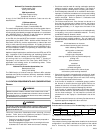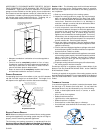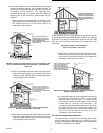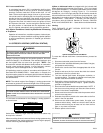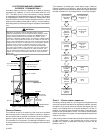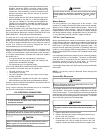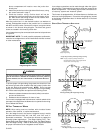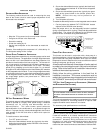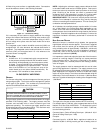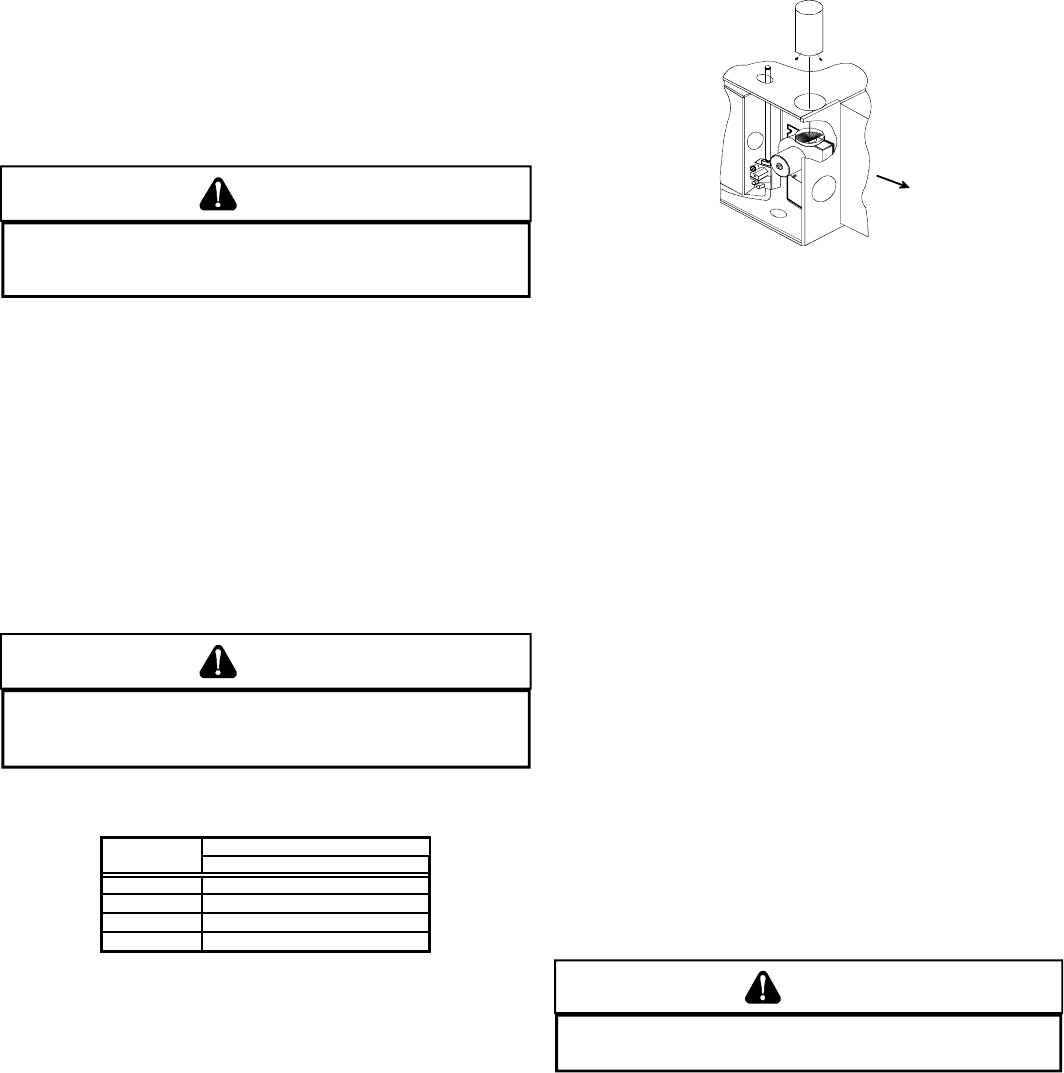
10
IO-247A 12/04
5.3.5 Louvers and Grilles:
In calculating free area in 5.3.3, consideration shall be given
to the blocking effect of louvers, grilles or screens protecting
openings. Screens used shall not be smaller than 1/4 inch
mesh. If the area through a design of louver or grille is known,
it should be used in calculating the size of opening required to
provide the free area specified. If the design and free area is
not known, it may be assumed that wood louvers will have 20-
25 percent free area and metal louvers and grilles will have
60-75 percent free area. Louvers and grilles shall be fixed in
the open position or interlocked with the equipment so that
they are opened automatically during equipment operation.
5.3.6 Special Conditions Created by Mechanical Exhausting
or Fireplaces:
Operation of exhaust fans, ventilation systems, clothes dryers,
or fireplaces may create conditions requiring special attention
to avoid unsatisfactory operation of installed gas utilization
equipment.
VI. CATEGORY I VENTING (VERTICAL VENTING)
WARNING
T
O PREVENT POSSIBLE PERSONAL INJURY OR DEATH DUE TO ASPHYXIATION,
THIS FURNACE MUST BE
C
ATEGORY
I
VENTED.
D
O NOT VENT USING
C
ATEGORY
III
VENTING.
Category I Venting is venting at a non-positive pressure. A furnace
vented as Category I is considered a fan-assisted appliance and
the vent system does not have to be “gas tight.” NOTE: Gas
furnaces with induced draft blowers draw products of combustion
through a heat exchanger allowing, in some instances, common
venting with natural draft appliances (i.e. water heaters).
All installations must be vented in accordance with National Fuel
Gas Code NFPA 54/ANSI Z223.1 - latest edition. In Canada, the
furnaces must be vented in accordance with the National Standard
of Canada, CAN/CSA B149.1 and CAN/CSA B149.2 - latest editions
and amendments.
NOTE: The vertical height of the Category I venting system must
be at least as great as the horizontal length of the venting system.
WARNING
T
O PREVENT POSSIBLE PERSONAL INJURY OR DEATH DUE TO ASPHYXIATION,
COMMON VENTING WITH OTHER MANUFACTURER'S INDUCED DRAFT APPLIANCS
IS NOT ALLOWED.
The minimum vent diameter for the Category I venting system is
as shown below:
MINIMUM VENT
UPFLOW
70 4 Inch
90 4 Inch
115 N/A
140
N/A
MODEL
Under some conditions, larger vents than those shown above may
be required or allowed.
When an existing furnace is removed from a venting system serving
other appliances, the venting system may be too large to properly
vent the remaining attached appliances.
Upflow or Horizontal units are shipped with the induced draft
blower discharging from the top of the furnace. (“Top” is as viewed
for an upflow installation.) The induced draft blower can be rotated
90 degrees for Category I venting (Figure 3). For horizontal
installations, a four inch single wall pipe can be used to extend the
induced draft blower outlet 1/2” beyond the furnace cabinet. Vent
the furnace in accordance with the National Fuel Gas Code NFPA
54/ANSI Z223.1 - latest edition. In Canada, vent the furnace in
accordance with the National Standard of Canada, CAN/CSA
B149.1 and CAN/CSA B149.2 - latest editions and amendments.
Venting
THIS FURNACE IS NOT DESIGN CERTIFIED TO BE
HORIZONTALLY VENTED.
Supply
Air
Upflow Rotated Induced Draft Blower
To rotate the induced draft blwer counterclockwise, proceed as
follows:
1. Disconnect electrical power from the furnace.
2. Disconnect the induced draft blower power leads, flue pipe,
and pressure switch tubing.
3. Remove the round cutout from the appropriate side of the
furnace.
4. Remove and save the four screws that hold the induced
draft blower to the flue collector box.
5. Turn the induced draft blower 90 degrees clockwise, or
counterclockwise. The gasket is adhered to the back plate
and will rotate with the blower assembly.
6. Reinstall the induced draft blower on the flue collector box,
using the four screws removed in Step 3. Tighten screws to
provide an airtight seal.
7. Reconnect the induced draft blower power leads. NOTE: If
the wires are not long enough, pull extra wire from the wire
bundle in the blower compartment.
8. Remove and save the screw that holds the pressure switch
to the furnace top panel.
9. Relocate the pressure switch to the same side as the flue
outlet in the hole provided.
10. Reconnect the draft blower power leads, flue pipe, and
pressure switch tubing. Make sure that all wires and the
pressure switch tubing are at least one inch from the flue
pipe, or any other hot surfaces.
11. Restore power to the furnace.
WARNING
NEVER ALLOW THE PRODUCTS OF COMBUSTION, INCLUDING CARBON
MONOXIDE, TO ENTER THE RETURN DUCTWORK OR CIRCULATION AIR SUPPLY.



